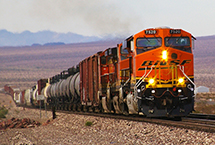 |
 |
|
| eNews • May 2015 | ||
| Promoting a Cost-Effective, Reliable and Competitive Transportation System |
||
 BNSF Retakes Share From Union Pacific After Buffett Rebuke byThomas Black
BNSF Retakes Share From Union Pacific After Buffett Rebuke byThomas Black
BNSF Railway Co. won back market share for grain and agriculture commodities that it lost to Union Pacific Corp. in 2014 when the railroad owned by Warren Buffett struggled to keep up with customer demand.
In last year’s first quarter, BNSF lost about 4 percentage points of market share for carrying grain, fertilizer and other farm-related goods to its main competitors, said John Miller, vice president for agriculture products at BNSF.
“We lost it and gained it all back in a very short period of time,” Miller said in a telephone interview Wednesday. “A lot of BNSF shippers that had to find other ways to ship during our more challenging times have come back to us.”
BNSF was overwhelmed by a surge in crude-by-rail shipments and a record grain crop last year, allowing Union Pacific, the largest U.S. railroad, and Kansas City Southern to lure away business. BNSF, which was bought by Berkshire Hathaway Inc. in 2010, saw its market share for all products in the western U.S. drop 1.2 percentage points to 48.3 percent, spurring Buffett to highlight the railroad’s struggles.
BNSF “disappointed many of its customers” even after outspending Union Pacific in prior years, Buffett said in his annual letter to shareholders on Feb. 28. “Clearly, we have a lot of work to do.”
The market-share gains, led by agriculture products, helped Union Pacific post total carload growth of 6.7 percent in 2014. With BNSF clawing back last year’s gains, Union Pacific’s volumes are taking a hit. BNSF’s grain carloads during the first 14 weeks of 2015 rose 27 percent while Union Pacific saw a 3 percent drop, according to statistics from the Association of American Railroads. Agriculture products last year accounted for 19 percent of BNSF’s freight revenue.
Union Pacific spokesman Aaron Hunt declined to comment on the company’s market share ahead of its earnings report Thursday.
Grain, Coal
During the first quarter, Union Pacific’s total carloads fell 2.3 percent, mostly because of drops in grain and coal, while BNSF posted growth of 0.8 percent, according to the association’s statistics.
BNSF increased its market share for agriculture products to 50 percent in the first three months of this year, while Union Pacific fell about 3 percentage points to 44.4 percent and Kansas City Southern, the fifth-largest U.S. railroad, saw a 1 percentage point slip to 5.5 percent, according to BNSF. For grain, BNSF boosted its market share to 58 percent from about 51 percent last year, the railroad said.
To improve train speeds and lower the amount of time railcars sit at terminals, BNSF plans to spend $6 billion this year after spending $5.5 billion in 2014 to build track, buy locomotives and hire crews. Union Pacific said 2015 capital expenditures will be about $4.3 billion.
BNSF’s outsized spending may be paying off. Average train speeds have increased to 24 miles per hour for the week of April 10, up from 21.2 mph for the same week last year and railcar dwell times have dropped 15 percent to about 25 hours. Buffett’s railroad is getting some help this year from slowing demand for oil trains as drilling activity in the Bakken region plummets, freeing up capacity.
Fast Grain
The railroad is moving as many as 2.8 trains with 110 cars of grain each month to the Pacific Northwest, and moved a record amount of grain in October through December, Miller said. Last year, the number of grain shuttle trains dropped to 1.8 per month, sparking ire from farmers waiting to ship their crops.
Now, customers are asking how the railroad is moving grain so fast instead of calling to complain, Miller said. BNSF added an extra set of tracks along about 75 miles (120 kilometers) of its route through North Dakota and Washington state in two separate sections, he said.
“The grain shippers were one of the first to really benefit from all the capacity we added in 2014,” Miller said. “It’s safe to say we can now take the freight the market wants to present to us.”
Source: Bloomberg Business
Soy Transportation Coalition |
|
